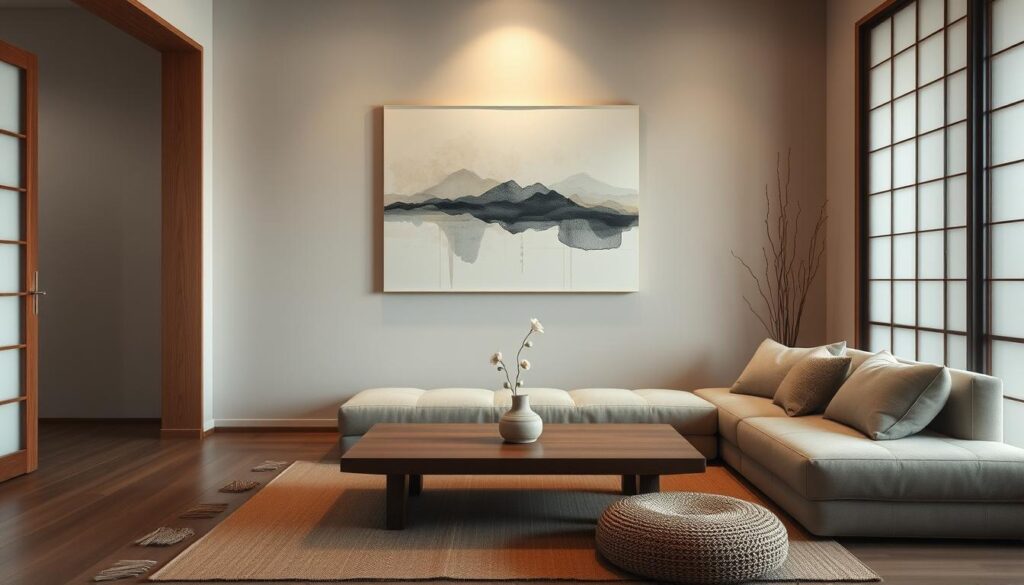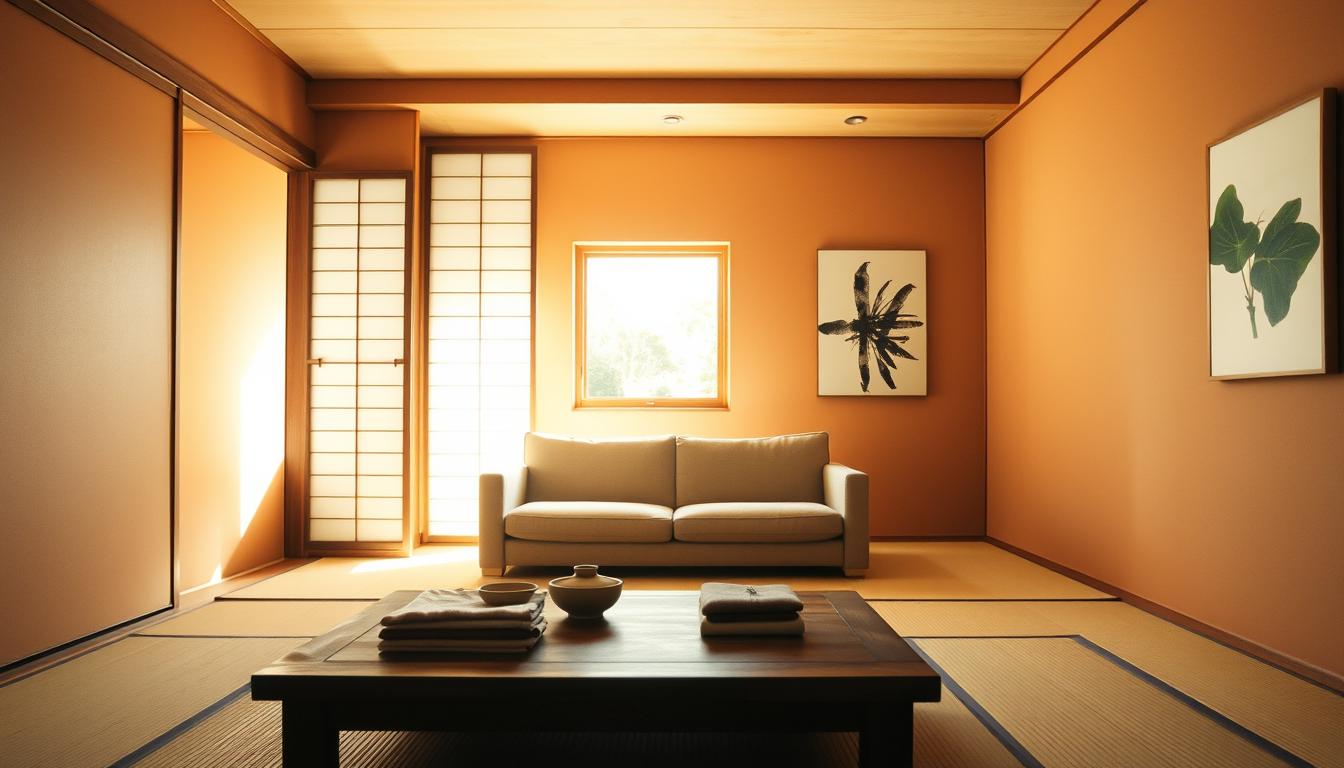Did you know Japanese interior design has been shaping homes worldwide for centuries? It blends minimalist elegance with a deep love for nature. This creates spaces that are both peaceful and stunning.
Japanese-inspired interiors focus on simplicity, natural materials, and calm. By using these elements, homeowners can make a cozy retreat. This retreat helps promote relaxation and well-being.
Key Takeaways
- Understanding the principles of Japanese interior design
- Applying minimalist japonism in modern homes
- Incorporating natural materials for a serene atmosphere
- Creating a sense of calm through simple decor
- Embracing the beauty of nature in interior spaces
Understanding the Essence of Japanese Interior Design
Japanese interior design is rooted in simplicity, balance, and a love for nature. It’s not just about looks; it’s a lifestyle that shapes how we see and feel spaces.
The Philosophy Behind Minimalism
Minimalism in Japanese design is more than clearing out clutter. It’s about making a space that encourages mindfulness and clarity. By focusing on the basics, Japanese interiors become calm and serene.
This minimalist style comes from Zen Buddhism, which values simplicity and the beauty of imperfection. It shows a cultural love for subtlety and restraint. In Japan, the space between things, called “ma“, is as important as the things themselves. This idea leads to thoughtful use of space, making Japanese interiors serene.
Balance and Harmony in Design
Balance and harmony are key in Japanese design. It’s about placing every element with care to create equilibrium. This balance is not just about looks; it guides the eye and movement through the space.
Harmony is achieved with natural materials and elements that reflect the seasons. Using wood, bamboo, and paper adds warmth and connects the space to nature. This connection is vital for harmony and well-being.
By embracing these principles, we can make interiors that are not just beautiful but also peaceful. Whether it’s through minimalism or balancing design elements, Japanese design offers a special way to create spaces that care for both body and soul.
Key Elements of Japanese Aesthetics
Japanese aesthetics are known for their simplicity and harmony with nature. This unique blend makes Japanese interior design stand out. It creates spaces that are both serene and functional.
Natural Materials and Textures
The use of natural materials is key in Japanese design. Wood, bamboo, and paper are used to create a warm atmosphere. These materials are often left natural to highlight their texture and beauty.
Traditional Japanese homes often have tatami mats made from grass or reeds. These mats are not just flooring but also connect us to nature.
Emphasis on Simplicity
Simplicity is a core principle in Japanese aesthetics. This is seen in the minimalist decor, where clutter is avoided. Each element is chosen for its beauty and function.
“The beauty of simplicity is a guiding principle in creating serene living spaces.”
By focusing on simplicity, Japanese design brings calm and tranquility. Neutral colors and avoiding extra ornamentation add to this calm.
Use of Light and Space
Light and space are crucial in Japanese design. Large windows and sliding doors made of paper or glass blur the indoor-outdoor line. This lets natural light fill the space.
This focus on light and space makes even small spaces feel open and airy. For more on Japanese design’s influence, check out our article on Japandi design. It mixes Japanese minimalism with Scandinavian functionality.
Popular Styles in Japanese Interior Design
Japanese interior design offers a wide range of styles. These styles mix old traditions with new trends. This mix makes Japanese design both timeless and fresh.
Traditional Japanese Homes
Traditional Japanese homes use natural materials like wood and paper. They also have tatami mats. These features make the homes simple and peaceful, blending well with nature.
These homes have sliding doors called shoji screens. They are made of paper or wood. These screens help divide spaces while keeping the home open. The tatami room design is also key, offering a quiet spot for rest and thought.
| Element | Description | Benefit |
|---|---|---|
| Tatami Mats | Traditional flooring made from woven grass or reeds | Creates a natural, serene atmosphere |
| Shoji Screens | Sliding doors or room dividers made from paper or wood | Defines spaces while maintaining openness |
| Natural Wood | Used extensively in construction and furniture | Adds warmth and character to the space |
Modern Interpretations
Modern Japanese interior design blends old traditions with new styles. It uses modern materials and tech but keeps the Japanese look. This mix is both new and true to tradition.
Modern designs often have simple decor and clean lines. They focus on being useful. Natural light and open spaces are also key, making the area feel light and free.
Zen-Inspired Spaces
Zen interior design aims to create a calm and meditative space. It’s influenced by Zen Buddhism. It values simplicity, natural beauty, and a connection to nature.
Zen spaces have calm colors and natural materials. They also have art and decor that bring peace and quiet.
Color Palette Choices in Japanese Design
In Japanese design, colors are more than just pretty. They help create balance and calm. The colors used reflect nature and Japan’s cultural values.
Earthy Tones and Neutrals
Earthy tones and neutrals are key in Japanese design. Shades of brown, beige, and taupe come from wood, stone, and earth. They make spaces feel warm and welcoming, linking indoors to outdoors.
Common earthy tones include:
- Terracotta
- Sienna
- Umber
- Soft grays
These colors are pleasing to the eye and create a peaceful setting. Natural materials and their colors add warmth and texture.
The Role of Color in Japanese Culture
Color is deeply rooted in Japanese culture, carrying emotions and meanings. Red means good luck and prosperity, while white represents purity and simplicity. It’s important to choose colors that are both beautiful and meaningful.
| Color | Cultural Significance |
|---|---|
| Red | Good luck, prosperity |
| White | Purity, simplicity |
| Green | Nature, harmony |
By picking colors that match these cultural values, Japanese design balances beauty and meaning.
Furniture Selection for Japanese Interiors
Choosing furniture for Japanese interiors is all about understanding traditional elements. We’ll look at what makes furniture embody the spirit of Japanese design.
Choosing Authentic Japanese Furniture
Authentic Japanese furniture is simple, functional, and made from natural materials. Traditional pieces like tatami mats, shoji screens, and low-seating furniture are key. We should pick furniture that shows these traditional qualities.
Multifunctional Solutions
In Japanese design, being able to do more than one thing is important. Furniture that can be used in different ways is both useful and keeps the space simple. For instance, a storage ottoman can be a seat and a place to store things. Adding such pieces can make our space more useful.
The Importance of Low Furniture
Low furniture is a big part of traditional Japanese interiors. It makes a space feel open and cozy, and often goes with tatami mats. Options like zashiki sofas and floor tables help create a laid-back vibe. Using low furniture can make our space feel more like Japan.
| Furniture Type | Characteristics | Benefits |
|---|---|---|
| Low-Seating Furniture | Low to the ground, simple design | Creates a sense of openness, encourages relaxed seating |
| Multifunctional Furniture | Serves more than one purpose | Practical, maintains minimalist aesthetic |
| Traditional Japanese Furniture | Natural materials, simple, functional | Authentic, reflects traditional Japanese design principles |
By picking furniture that fits these principles, we can make a Japanese-inspired space that’s both lovely and practical.
Integrating Nature with Indoor Spaces
Japanese design is all about blending indoor spaces with nature. This creates a calm and peaceful vibe. Elements like indoor gardens, plants, and water features make spaces look better and feel more balanced.
Indoor Gardens and Plants
Indoor gardens and plants are key in Japanese-inspired interiors. They bring nature inside, making spaces feel soothing. Bonsai trees, ferns, and bamboo are favorites for their beauty and cultural meaning.
Choosing the right plants is important. Think about the light, temperature, and care they need. For example, moss and ferns do well in low light, while bamboo needs more light and water.
Water Features as Design Elements
Water features are essential in Japanese design. They add a calming sound and beauty to a space. In Japanese design, they help create a peaceful and natural feel.
There are many water features to choose from, like small fountains, aquariums, and ponds. The right choice depends on the space and how much care you want to give.
Bringing the Outdoors In
Japanese design focuses on bringing the outdoors inside. This is done with indoor gardens, water features, and natural materials. Wood, stone, and paper add warmth and character.
Designers use big windows, sliding doors, and open plans to connect indoors with outdoors. This lets in more natural light and views.
| Design Element | Purpose | Examples |
|---|---|---|
| Indoor Gardens | Bring nature indoors, create a peaceful atmosphere | Bonsai trees, ferns, bamboo |
| Water Features | Create a calming ambiance, add visual appeal | Small fountains, aquariums, indoor ponds |
| Natural Materials | Add warmth and character to a space | Wood, stone, paper |
Lighting Techniques in Japanese Homes
Lighting in Japanese homes is all about finding the right mix of natural and artificial light. This mix is key to creating a calm and inviting atmosphere. It’s what makes Japanese homes so welcoming.
Natural Light Utilization
Using natural light is a big part of Japanese lighting. Homes have big windows and sliding doors made of paper or glass, like shoji screens. These help bring in lots of natural light during the day.
Shoji screens are special because they filter the light. They make a soft, gentle glow that lights up the rooms softly.
For more on using Japanese lighting in modern homes, check out our guide on Japanese lighting fixtures.
Traditional and Modern Fixtures
Artificial lighting is also important in Japanese homes. Traditional lights, like akari or paper lanterns, add warmth and beauty. They are simple yet elegant, fitting well with the minimalist style.
In modern Japanese homes, you’ll find a mix of old and new lighting. Modern lights are functional and simple, often using LED for energy saving. The choice between old and new depends on the home’s design and what the owners like.
The Role of Space in Japanese Design
Japanese interior design focuses on using space to bring calm and serenity. It’s all about simplicity, balance, and blending with nature. This careful planning is at the heart of Japanese design.
Open Floor Plans
Open floor plans are key to achieving calm. By reducing walls, spaces feel larger and more connected. This approach makes rooms flow smoothly together.
Open floor plans also help merge different areas like living and dining. This creates a unified and peaceful home environment. For more on Japanese design, check out BHG’s guide.
Dividing Spaces with Shoji Screens
Shoji screens are great for dividing spaces while keeping them open. Made from translucent materials, they let light pass through softly.
These screens are not just practical but also add beauty to a room. They bring a touch of Japanese elegance. They can separate areas or provide privacy.
Tatami room designs show how space is used wisely in Japanese interiors. Tatami rooms are flexible, used for guests, studies, or meditation. They are designed to be versatile.
| Design Element | Purpose | Benefits |
|---|---|---|
| Open Floor Plans | Create a sense of flow and continuity | Makes spaces feel larger, promotes harmony |
| Shoji Screens | Divide spaces, add aesthetic appeal | Provides flexibility, introduces traditional elegance |
| Tatami Rooms | Multifunctional spaces | Enhances flexibility, promotes tranquility |
Decorating with Japanese Art and Crafts
To add Japanese elegance to your home, think about using traditional art and crafts. Japanese decor values simplicity and natural materials. Adding artisanal crafts can make your space serene and culturally rich.

Incorporating Ceramics and Textiles
Ceramics and textiles are key in Japanese design. Ceramics add warmth and authenticity with their earthy tones and simple shapes. Kenji Ekuan, a famous Japanese designer, said ceramics show nature’s essence.
Traditional Japanese ceramics, like Raku pieces, are loved for their simplicity and rustic beauty.
Textiles are also vital in Japanese decor. Fabrics like silk and cotton make elegant items like shoji screens and table runners. Their intricate patterns and soft colors add depth and interest to any room. Using these can blend traditional and modern design well.
The Influence of Calligraphy
Calligraphy is a big part of Japanese art that can enhance your decor. It’s not just writing; it’s about expressing emotions and spirit through strokes. A calligraphy piece can be a room’s centerpiece, adding sophistication and cultural depth.
“Calligraphy is the art of expressing the inner self through the beauty of written characters.” –
You can add calligraphy to your decor in many ways. It could be a framed piece on a wall or a custom artwork. The important thing is to pick pieces that speak to you and match your home’s style.
By using Japanese art and crafts, you can make a home that’s not just beautiful but also rich in culture. Ceramics, textiles, and calligraphy can help you create a peaceful and elegant space that shows the timeless beauty of Japanese design.
Cultural Considerations in Japanese Design
Japanese interior design is special because it mixes old and new. It tells a story of culture and modern life. This mix is not just about looks; it’s about honoring the past and living in the present.
Respect for Tradition
Traditional Japanese decor is simple and natural. It connects deeply with nature. These choices show respect for tradition and heritage.
For example, tatami mats and shoji screens are more than just practical. They hold cultural value. Yuko Tanaka, a Japanese interior designer, says, “Adding old elements to new spaces keeps our culture alive.”
The Balance of Modernity and Heritage
Mixing modern and traditional Japanese design is key. Modern materials meet traditional craftsmanship in homes. For instance, a modern home might have sleek furniture and a washitsu with tatami flooring.
“The fusion of old and new in Japanese design creates a dynamic and harmonious living space that honors the past while embracing the present.”
To blend old and new, think about each design’s cultural value. Choose modern furniture that’s simple and clean. This way, it won’t clash with traditional Japanese beauty.
- Choose furniture that reflects Japanese minimalism.
- Incorporate natural materials and textures.
- Use lighting to create ambiance and highlight traditional elements.
By understanding and respecting these cultural values, you can make a space that’s beautiful and meaningful.
Tips for Implementing Japanese Design in Your Home
To bring Japanese design into your home, start with small changes. Use natural materials like wood and paper. They add warmth and authenticity to your space.
Practical Changes to Get You Started
Start with small changes. Replace heavy curtains with shoji screens. Add simple accents, like a vase or Japanese art. These changes will make your space more balanced and harmonious.
DIY Projects for an Authentic Feel
Try DIY projects that show off Japanese craftsmanship. Create a bonsai tree or a wooden planter. These projects add a personal touch and connect you to Japanese culture.
By adding these elements, you can make your home peaceful and inviting. It will reflect the beauty of minimalist japonism.



